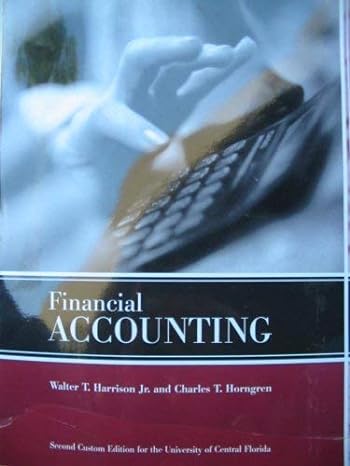Question
10. Even though inventory is an asset, an error in ending inventory cost will cause net income to be erroneously reported. a. True b. False
10.
Even though inventory is an asset, an error in ending inventory cost will cause net income to be erroneously reported.
| a. True | ||
| b. False |
20.
If outstanding checks are discovered during a bank reconciliation, the company must make an adjusting entry in its accounting records.
| a. True | ||
| b. False |
24.
A company may use the direct write-off method of accounting for uncollectible accounts receivable if the results of doing so are not materially different from the results obtained by using an estimating procedure.
| a. | True | |
| b. | False |
25.
The revenue recognition principle requires that accrued interest on outstanding notes receivable be recorded at the end of each accounting period.
| a. True | ||
| b. False |
26.
Accounts receivable can be sold in order to have cash immediately available for use instead of waiting to collect from the customer.
| a. True | ||
| b. False |
28.
Generally Accepted Accounting Principles requires that accounts receivable and notes receivable should be written-off to expense immediately, if not collected by the due date.
| a. True | ||
| b. False |
29.
Rather than waiting 30 days to collect a receivable from a sale to a customer, the merchant factors that receivable with a finance company. The merchant will receive less cash from the factor than it would have received from the customer in 30 days.
| a. True | ||
| b. False |
31.
Cellar Company began December with 200 units of an item that cost $40 per unit. On 12/16 it purchased 600 more units at $50 each. Then on 12/22 Cellar Company sold 700 of those units for a price of $90 per unit. Using FIFO and perpetual inventory costing, Ending Inventory would be
| a. $ 4,000 | ||
| b. $ 5,000 | ||
| c. $ 9,000 | ||
| d. $10,000 |
32.
Cellar Company began December with 200 units of an item that cost $40 per unit. On 12/16 it purchased 600 more units at $50 each. Then on 12/22 Cellar Company sold 700 of those units for a price of $90 per unit. Using FIFO perpetual, Cost of Goods Sold would be
| a. $ 63,000 | ||
| b. $ 34,000 | ||
| c. $ 33,000 | ||
| d. $ 28,000 |
33.
Cellar Company began December with 200 units of an item that cost $40 per unit. On 12/16 it purchased 600 more units at $50 each. Then on 12/22 Cellar Company sold 700 of those units for a price of $90 per unit. Using FIFO, Gross Profit would be
| a. $ 63,000 | ||
| b. $ 29,000 | ||
| c. $ 30,000 | ||
| d. $ 31,000 |
34.
Cellar Company began December with 200 units of an item that cost $40 each. On 12/16 it purchased 600 more units at $50 each. Then on 12/22 Cellar Company sold 700 of those units for a price of $90 per unit. Using LIFO perpetual, Ending Inventory would be
| a. $ 3,000 | ||
| b. $ 4,000 | ||
| c. $ 5,000 | ||
| d. $ 9,000 | ||
| e. $ 8,000 |
35.
Cellar Company began December with 200 units of an item that cost $40 each. On 12/16 it purchased 600 more units at $50 each. Then on 12/22 Cellar Company sold 700 of those units for a price of $90 per unit. Using LIFO perpetual, Cost of Goods Sold would be
| a. $ 34,000 | ||
| b. $ 33,000 | ||
| c. $ 30,000 | ||
| d. $ 29,000 |
Step by Step Solution
There are 3 Steps involved in it
Step: 1

Get Instant Access to Expert-Tailored Solutions
See step-by-step solutions with expert insights and AI powered tools for academic success
Step: 2

Step: 3

Ace Your Homework with AI
Get the answers you need in no time with our AI-driven, step-by-step assistance
Get Started


